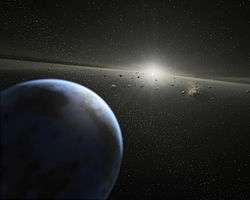HD 69830 b
| Exoplanet | List of exoplanets | |
|---|---|---|
| Parent star | ||
| Star | HD 69830 | |
| Constellation | Puppis | |
| Right ascension | (α) | 08h 18m 23.947s[1] |
| Declination | (δ) | −12° 37′ 55.81″[1] |
| Apparent magnitude | (mV) | 5.95 |
| Distance | 40.7 ± 0.2[1] ly (12.49 ± 0.05[1] pc) | |
| Spectral type | G8V | |
| Mass | (m) | 0.86 ± 0.03 M☉ |
| Radius | (r) | 0.89 R☉ |
| Temperature | (T) | 5385 ± 20 K |
| Metallicity | [Fe/H] | −0.05 ± 0.02 |
| Age | 5.1–6.1 Gyr | |
| Orbital elements | ||
| Semi-major axis | (a) | 0.0785 AU |
| Eccentricity | (e) | 0.1 ± 0.04 |
| Orbital period | (P) | 8.667 ± 0.003 d |
| Argument of periastron |
(ω) | 340 ± 26° |
| Time of periastron | (T0) | 2,453,496.8 ± 0.06 JD |
| Semi-amplitude | (K) | 3.51 ± 0.15 m/s |
| Physical characteristics | ||
| Minimum mass | (m sin i) | 0.033 MJ |
| Temperature | (T) | ~804 |
| Discovery information | ||
| Discovery date | May 18, 2006 | |
| Discoverer(s) | Lovis et al.[2] | |
| Discovery method | Radial velocity | |
| Discovery status | Published[2] | |
| Database references | ||
| Extrasolar Planets Encyclopaedia | data | |
| SIMBAD | data | |
| Exoplanet Archive | data | |
| Open Exoplanet Catalogue | data | |
HD 69830 b is a Neptune-mass or super-Earth-mass exoplanet orbiting the star HD 69830. It is 10 times more massive than Earth, making it the least massive known exoplanet in the system. It also orbits very close to its parent star and takes 82/3 days to complete an orbit.
This is likely to be a rocky planet, not a gas giant.[2] If it had formed as a gas giant, it would have stayed that way.[3]
If HD 69830 b is a terrestrial planet, models predict that tidal heating would produce a heat flux at the surface of about 55 W/m2. This is 20 times that of Io.[4]
References
- 1 2 3 4 van Leeuwen, F. (2007). "Validation of the new Hipparcos reduction". Astronomy and Astrophysics. 474 (2): 653–664. arXiv:0708.1752
 . Bibcode:2007A&A...474..653V. doi:10.1051/0004-6361:20078357.Vizier catalog entry
. Bibcode:2007A&A...474..653V. doi:10.1051/0004-6361:20078357.Vizier catalog entry - 1 2 3 Lovis, Christophe; et al. (2006). "An extrasolar planetary system with three Neptune-mass planets" (PDF). Nature. 441 (7091): 305–309. arXiv:astro-ph/0703024
 . Bibcode:2006Natur.441..305L. doi:10.1038/nature04828. PMID 16710412.
. Bibcode:2006Natur.441..305L. doi:10.1038/nature04828. PMID 16710412. - ↑ H. Lammer; et al. (2007). "The impact of nonthermal loss processes on planet masses from Neptunes to Jupiters" (PDF). Geophysical Research Abstracts. 9 (07850).
- ↑ Jackson, Brian; Richard Greenberg; Rory Barnes (2008). "Tidal Heating of Extra-Solar Planets". ApJ. 681 (2): 1631. arXiv:0803.0026
 . Bibcode:2008ApJ...681.1631J. doi:10.1086/587641.
. Bibcode:2008ApJ...681.1631J. doi:10.1086/587641.
Coordinates: ![]() 08h 18m 23.9s, −12° 37′ 55.8″
08h 18m 23.9s, −12° 37′ 55.8″
This article is issued from Wikipedia - version of the 9/25/2016. The text is available under the Creative Commons Attribution/Share Alike but additional terms may apply for the media files.
